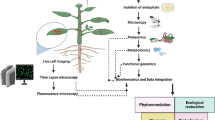Abstract
In this study, a cDNA microarray was developed from over 60,000 mRNA readings to analyze the expression profiles of transcriptomes of Haematococcus lacustris under astaxanthin-inducing culture conditions, high irradiance and nitrate starvation. Among 20,033 genes on the cDNA microarray, 2,675 genes exhibited a twofold or greater difference in expression. Of these, 1,333 genes were up-regulated and 1,342 genes were down-regulated. A significant decrease in the expression of chlorophyll biosynthesis and light harvesting complex (LHC) related genes were observed under astaxanthin inducing conditions (forming red cyst cells). On the other hand, respirationrelated genes, lipid metabolism-related genes and stress response-related genes were activated in the red cyst cells under stress conditions. These results enabled a better understanding of the cell responses during stress induction of H. lacustris such as photosynthesis, respiration, and some biopathways.
Similar content being viewed by others
References
Boussiba, S. (2000) Carotenogenesis in the green alga Haematococcus pluvialis: Cellular physiology and stress response. Physiol. Plant 108: 111–117.
Guerin, M., M. E. Huntley, and M. Olaizola (2003) Haematococcus astaxanthin: Applications for human health and nutrition. Trends Biotechnol. 21: 210–216.
Kobayashi, M., T. Kakizono, and S. Nagai (1993) Enhanced carotenoid biosynthesis by oxidative stress in acetate-induced cyst cells of a green unicellular alga, Haematococcus pluvialis. Appl. Environ. Microbiol. 59: 867–873.
Kim, J. -D. (2008) Proteomic analysis of protein expression patterns associated with astaxanthin accumulation by green alga haematococcus pluvialis (Chlorophyceae) under high light stress. J. Microbiol. Biotechnol. 16: 1222–1228.
Tran, N. P., J. K. Park, and C. G. Lee (2009) Proteomics analysis of proteins in green alga Haematococcus lacustris (Chlorophyceae) expressed under combined stress of nitrogen starvation and high irradiance. Enz. Microb. Technol. 45: 241–246.
Eom, H., C. G. Lee, and E. Jin (2006) Gene expression profile analysis in astaxanthin-induced Haematococcus pluvialis using a cDNA microarray. Planta 223: 1231–1242.
Kim, M., S. Park, J. E. W. Polle, and E. Jin (2010) Gene expression profiling of Dunaliella sp. acclimated to different salinities. Phycol. Res. 58: 17–28.
Kok, B. (1949) On the interrelation of respiration and photosynthesis in green plants. Biochim. Biophys. Acta 3: 625–631.
Kobayashi, M. (2003) Astaxanthin biosynthesis enhanced by reactive oxygen species in the green alga Haematococcus pluvialis. Biotechnol. Bioproc. Eng. 8: 322–330.
Vidhyavathi, R., L. Venkatachalam, R. Sarada, and G. A. Ravishankar (2008) Regulation of carotenoid biosynthetic genes expression and carotenoid accumulation in the green alga Haematococcus pluvialis under nutrient stress conditions. J. Exp. Bot. 59: 1409–1418.
Novoselov, S. V., M. Rao, N. V. Onoshko, H. Zhi, G. V. Kryukov, Y. Xiang, D. P. Weeks, D. L. Hatfield, and V. N. Gladyshev (2002) Selenoproteins and selenocysteine insertion system in the model plant cell system, Chlamydomonas reinhardtii. EMBO J. 21: 3681–3693.
Powers, H. J. (2003) Riboflavin (vitamin B-2) and health. Am. J. Clin. Nutr. 77: 1352–1360.
Yokozawa, T., E. Dong, Z. W. Liu, and M. Shimizu (1997) Antioxidative activity of flavones and flavonols in vitro. Phytother. Res. 11: 446–449.
Blokker, P., S. Schouten, H. Van Den Ende, J. W. De Leeuw, and S. Sinninghe Damste Jaap (1998) Cell wall-specific [omega]-hydroxy fatty acids in some freshwater green microalgae. Phytochem. 49: 691–695.
Levy, H., T. Tal, A. Shaish, and A. Zamir (1993) Cbr, an algal homolog of plant early light-induced proteins, is a putative zeaxanthin binding protein. J. Biol. Chem. 268: 20892–20896.
Vidhyavathi, R., R. Sarada, and G. A. Ravishankar (2009) Expression of carotenogenic genes and carotenoid production in Haematococcus pluvialis under the influence of carotenoid and fatty acid synthesis inhibitors. Enz. Microb. Technol. 45: 88–93.
Lotan, T. and J. Hirschberg (1995) Cloning and expression in Escherichia coli of the gene encoding [beta]-C-4-oxygenase, that converts [beta]-carotene to the ketocarotenoid canthaxanthin in Haematococcus pluvialis. FEBS Lett. 364: 125–128.
Li, Y., M. Sommerfeld, F. Chen, and Q. Hu (2010) Effect of photon flux densities on regulation of carotenogenesis and cell viability of Haematococcus pluvialis (Chlorophyceae). J. Appl. Phycol. 22: 253–263.
Wolff, M., M. Seemann, B. Tse Sum Bui, Y. Frapart, D. Tritsch, A. G. Estrabot, M. Rodriguez-Concepcion, A. Boronat, A. Marquet, and M. Rohmer (2003) Isoprenoid biosynthesis via the methylerythritol phosphate pathway: the (E)-4-hydroxy-3-methylbut-2-enyl diphosphate reductase (LytB/IspH) from Escherichia coli is a [4Fe-4S] protein. FEBS Lett. 541: 115–120.
Fox, D. T. and C. D. Poulter (2002) Synthesis of (E)-4-Hydroxydimethylallyl diphosphate. An intermediate in the methyl erythritol phosphate branch of the isoprenoid pathway. J. Org. Chem. 67: 5009–5010.
Rohmer, M. (1999) The discovery of a mevalonate-independent pathway for isoprenoid biosynthesis in bacteria, algae and higher plants. Nat. Prod. Rep. 16: 565–574.
Benoit, S., R. Nour-Eddine, R. Jaouad, and L. Yves (2001) Astaxanthin accumulation in Haematococcus requires a cytochrome P450 hydroxylase and an active synthesis of fatty acids. FEBS Lett. 500: 125–128.
Bogos, B., B. Ughy, I. Domonkos, H. Laczko-Dobos, J. Komenda, L. Abasova, K. Cser, I. Vass, A. Sallai, H. Wada, and Z. Gombos (2009) Phosphatidylglycerol depletion affects photosystem II activity in Synechococcus sp. PCC 7942 cells. Photosynth. Res. 103: 19–30.
Author information
Authors and Affiliations
Corresponding author
Rights and permissions
About this article
Cite this article
Kim, DK., Hong, SJ., Bae, JH. et al. Transcriptomic analysis of Haematococcus lacustris during astaxanthin accumulation under high irradiance and nutrient starvation. Biotechnol Bioproc E 16, 698–705 (2011). https://doi.org/10.1007/s12257-011-0081-z
Received:
Accepted:
Published:
Issue Date:
DOI: https://doi.org/10.1007/s12257-011-0081-z




